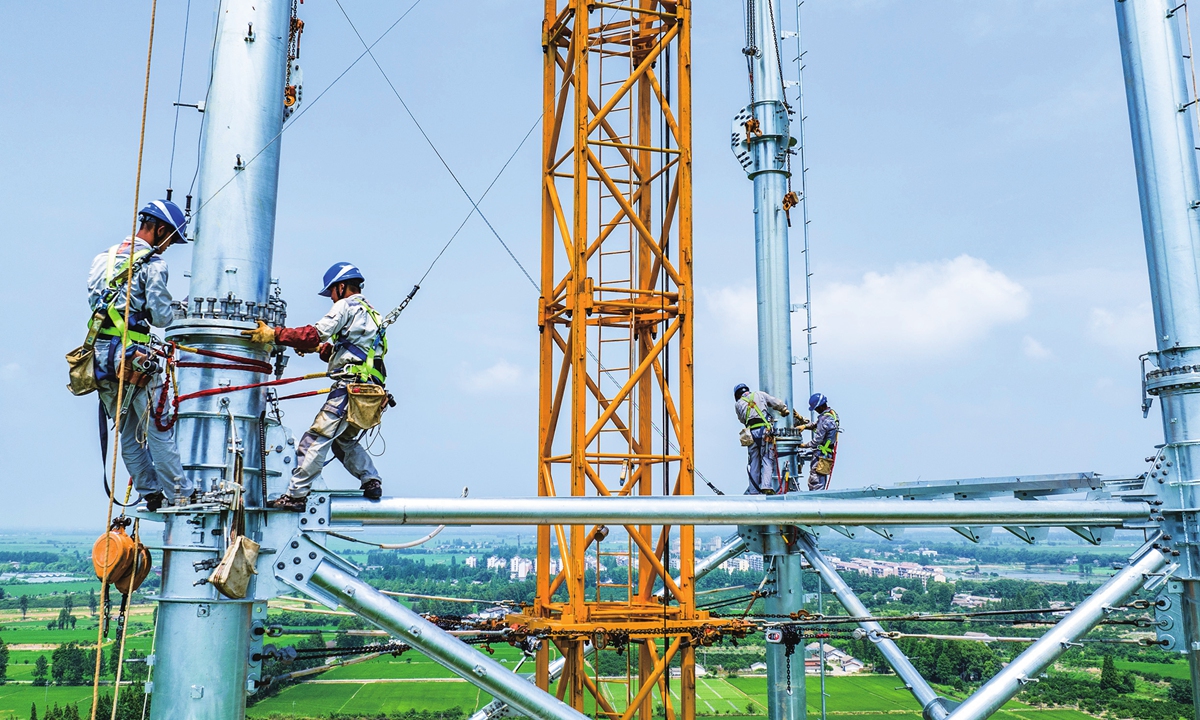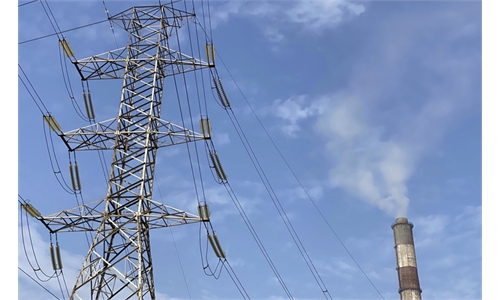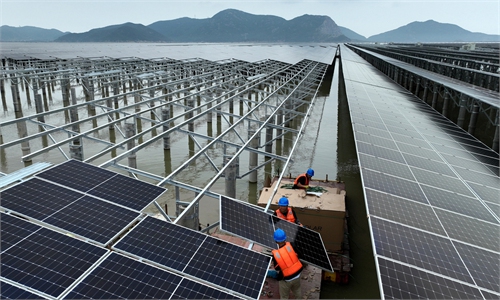
Workers of a power transmission company based in East China's Anhui Province install UHV transmission steel pipe towers in Nanchang, East China's Jiangxi Province on June 1, 2023. Power suppliers are ramping up to deal with an energy consumption peak that has come ahead of schedule amid a tight balance of supply, driven by hot weather in many areas. Photo: cnsphoto
A scorching heatwave shattering temperature records in Beijing, Tianjin, and Hebei Province has posed challenges for local power suppliers. With some areas experiencing temporary power curbs, electricity service providers are stepping up their efforts and working around the clock to ensure a stable power supply amid the extreme weather conditions.
Several national-level meteorological observatories, including those in Beijing, Tianjin, and Hebei, have reported record-breaking high temperatures. According to the China Meteorological Administration, the eastern part of North China will continue to experience high temperatures for the next 10 days, with around eight days of extremely hot weather.
A majority of places in Beijing and the surrounding regions have issued red-alert high temperature warnings, a very rare case at this time of year. The land surface temperatures in the North China region have generally exceeded 60 C, with the highest land surface temperature reaching 71.8 C, according to the China Meteorological Administration and media reports.
High temperatures have put pressure on power supplies, with some places reporting temporary power curbs due to the sudden increase of electricity use.
The increase in electricity demand has led to power failures, resulting in blackouts in some parts of Shijiazhuang, provincial capital of Hebei, an employee with the State Grid Shijiazhuang Electric Power Supply Co said when reached by the Global Times on Saturday.
Several villages in the region experienced power curbs but resumed the supply in a day. "It's hard to say whether there will be more power outages in the future," the person said.
Under normal circumstances, if there are any issues or faults, ordinarily the company immediately dispatches local staff to carry out repairs. However, in the case of extremely hot weather, it becomes challenging for workers to perform outdoor tasks for extended periods of time, the Global Times learned from the employee.
"As a result, the time required to address the faults may be longer, and the difficulty of handling them may also increase," he said.
"We have already requested power supply units to take preventive measures and be prepared, remaining on standby 24 hours a day. In case of any issues, repairs will be carried out promptly," the employee further noted, adding that priority will be given to meeting the electricity needs of residents for daily living.
Another employee with a local power generation company told the Global Times on condition of anonymity on Saturday that their power generation is currently operating normally.
"The amount of electricity we generate is in accordance with the planned schedule, and is operating smoothly at the moment," the person said.
In addition to some temporary and sporadic power curbs, electricity supply in the high-temperature region is generally smooth and stable, the Global Times learned.
Power supply in areas such as Beijing and Tianjin for which the company is responsible is largely stable despite high temperatures, an employee with the State Grid Beijing Electric Power Co told the Global Times on Saturday.
The company has dispatched some 9,300 personnel and over 100 emergency power generator vehicles to secure electricity supply.
In recent days, Beijing has experienced a continuous heatwave, resulting in a significant increase in the load on Beijing's power grid. Compared to the same period in 2022, the load has increased by approximately 30 percent, with cooling loads such as air conditioning accounting for 35 percent of the total load, Zhao Rui, chief engineer of the Beijing Power Dispatching and Control Center at State Grid Beijing Electric Power Company, told media.
"Because this summer is relatively hot, the power load will definitely increase in relative terms, but it has not yet exceeded the capacity of the power grid," the employee told the Global Times.
During major holidays and important exams like the college entrance examination gaokao, there are usually measures in place to ensure uninterrupted power supply, she said.
In the North China region, the number of extremely hot days came to 6.4, which was 3.1 days more than the long-term average of 3.3 days for the same period in previous years. This makes it the fifth highest number of hot days in history since 1961, according to media reports.
"Since the establishment of the observatory, it is the first time we have experienced two consecutive days with temperatures exceeding 40 C," said Zhang Yingxin, the chief forecaster at the Beijing Meteorological Observatory, the Paper.cn reported.
Due to the influence of a strong warm air mass, high temperatures will persist from Friday to Sunday, with most areas reaching a maximum temperature of 37 to 40 C.



